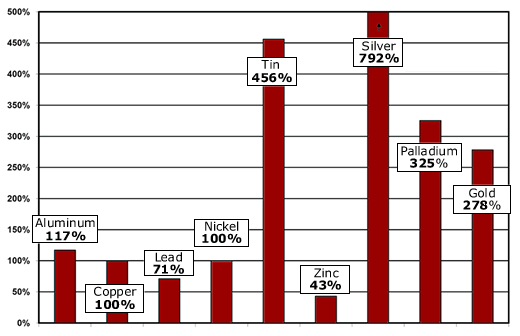| Home | About Us | Resources | Archive | Free Reports | Market Window |
The Right Way To Look At Commodity PricesBy
Tuesday, February 21, 2006
The effects of rising commodity prices are turning up many unexpected places... For example, my old friend from college, Ian, is a writer for Shooting Times, a UK-based hunting magazine. He’s a countryside expert. The subjects of his interviews are usually farmers, hunters or gun experts. His stories are about vermin and foxhunting. A pair of muddy Wellington boots is his favorite footwear. Ian doesn’t know anything about economics or commodity prices. He’s never even heard of Alan Greenspan... Yet the next article he’ll write is about the price of lead! Lead has risen 200% in the last three years. In January 2003, lead sold for less than 20 cents per pound. Now it’s over 60 cents. Ian says lead prices are a major story in the shooting industry, and in particular, for the manufacturers of shotgun cartridges. Here’s another example... on Wednesday, USA Today tells us two new coal miner-training centers were opened in West Virginia last month. The coal industry is looking for 7,000 new recruits. As the paper put it, “Coal suddenly has cachet. But there aren't enough miners to dig it up.” The last time I found commodity headlines like this was in the old newspaper archives from the 1970s at my local library. They marked the final stages of the previous bull market in commodities... There’s good reason for all the buzz right now. Commodities prices are hot, and in many cases, they’re breaking multi-decade records. Just look at these price moves, starting January 2001, measured to the highest price peak for each commodity: Aluminum... +94% All this leads to an important question: With all the recent fuss about commodities and their high prices, is it time to take our money from commodities and invest in something else? Here at DailyWealth, we believe the answer is ‘no.’ Even though prices have come up a long way, we think commodities are still fairly cheap. Let me explain... Commodities are priced in dollars. But – as a result of inflation - $500 today is a much smaller sum than $500 in 1980. There’s no point in comparing historical prices with current prices unless you make an adjustment for the dollar’s depreciation. The press doesn’t understand this simple fact. They use these comparisons to produce dramatic headlines like “Gold at highest price in 26 years.” The reality is, they’re totally off base. To get the real picture of where we are in the commodity price cycle, we have to strip out the fluctuations in the dollar’s value. We call the result a “constant-dollar price.” The following chart shows the percentage each commodity would have to rise to reach its constant dollar high of the last 25 years. Take palladium for example... In January of this year, the Financial Times reported that palladium had reached an “all-time high.” When we look at the real picture – using constant dollars – we see palladium needs to rise a further 325% to make an all-time high. Gold hit $850 an ounce in January 1980. Today gold is around $550 an ounce. The press would say we’re 55% from the 1980 peak. This is incorrect. In order for gold to surpass its 1980 value, it would have to trade at $2,150... a 278% increase from today’s price level. Percent Appreciation From Current Price Levels To This is great news for commodity investors. The low supply/high demand conditions are in place for the mother of all commodity bull markets – a bull market that’s far stronger than anything we saw in the 1970s. Most commodities are still less than half the levels they were at when the previous bull market ended. So... the next time you hear someone commenting on how expensive gasoline is, or how the high prices of shotgun shells are reducing the demand for hunting, maybe you can tell them the real story... You can tell them a look back at history with the right perspective shows commodity prices still have a long way to go. Good Investing, Tom Dyson Market NotesMARKET NOTES
NEW HIGHS OF NOTE LAST WEEK
Syngenta AG (SYT)… the market votes for genetically modified food Northrup Grumman (NOC)… defense spending booming Norfolk Southern (NSC)… railroads Caterpillar (CAT)… construction and mining equipment Merrill Lynch (MER)… financial services Cummins (CMI)… diesel engines Rick’s Cabaret (RICK)… gentleman’s clubs Merck (MRK)… Big Pharma Akamai Technologies (AKAM)… see Jan. 19 edition of DailyWealth German DAX Composite ($DAX)… German stocks rise amidst pessimism NEW LOWS OF NOTE LAST WEEK |
Recent Articles
|


